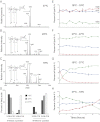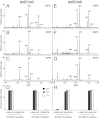LPS remodeling is an evolved survival strategy for bacteria
- PMID: 22586119
- PMCID: PMC3365160
- DOI: 10.1073/pnas.1202908109
LPS remodeling is an evolved survival strategy for bacteria
Erratum in
- Proc Natl Acad Sci U S A. 2012 Aug 21;109(34):13877
Abstract
Maintenance of membrane function is essential and regulated at the genomic, transcriptional, and translational levels. Bacterial pathogens have a variety of mechanisms to adapt their membrane in response to transmission between environment, vector, and human host. Using a well-characterized model of lipid A diversification (Francisella), we demonstrate temperature-regulated membrane remodeling directed by multiple alleles of the lipid A-modifying N-acyltransferase enzyme, LpxD. Structural analysis of the lipid A at environmental and host temperatures revealed that the LpxD1 enzyme added a 3-OH C18 acyl group at 37 °C (host), whereas the LpxD2 enzyme added a 3-OH C16 acyl group at 18 °C (environment). Mutational analysis of either of the individual Francisella lpxD genes altered outer membrane (OM) permeability, antimicrobial peptide, and antibiotic susceptibility, whereas only the lpxD1-null mutant was attenuated in mice and subsequently exhibited protection against a lethal WT challenge. Additionally, growth-temperature analysis revealed transcriptional control of the lpxD genes and posttranslational control of the LpxD1 and LpxD2 enzymatic activities. These results suggest a direct mechanism for LPS/lipid A-level modifications resulting in alterations of membrane fluidity, as well as integrity and may represent a general paradigm for bacterial membrane adaptation and virulence-state adaptation.
Conflict of interest statement
The authors declare no conflict of interest.
Figures

 ) for 2 and 2′ positions of Fn grown at 18 °C (black), 25 °C (gray), and 37 °C (white) (n = 2). (E) Percentage of lipid A species isolated at 18 °C. Red diamond, m/z 1609; blue circle, m/z 1637; green triangle, m/z 1665. (F) Percentage of lipid A species isolated at 37 °C. (G) Percentage of lipid A species isolated at 18 °C then switched to 37 °C. (H) Percentage of lipid A species isolated at 37 °C then switched to 18 °C. For all data points (E–H) (n = 3 ± SE).
) for 2 and 2′ positions of Fn grown at 18 °C (black), 25 °C (gray), and 37 °C (white) (n = 2). (E) Percentage of lipid A species isolated at 18 °C. Red diamond, m/z 1609; blue circle, m/z 1637; green triangle, m/z 1665. (F) Percentage of lipid A species isolated at 37 °C. (G) Percentage of lipid A species isolated at 18 °C then switched to 37 °C. (H) Percentage of lipid A species isolated at 37 °C then switched to 18 °C. For all data points (E–H) (n = 3 ± SE).

 ) for 2 and 2′ positions of lpxD1-null Fn grown at 18 °C (black), 25 °C (gray), and 37 °C (white). MS of lipid A from Fn lpxD2-null mutant grown at 18 °C (E), 25 °C (F), and 37 °C (G), respectively. Dominant lipid A was locked at m/z 1665. (H) Acyl group frequency (
) for 2 and 2′ positions of lpxD1-null Fn grown at 18 °C (black), 25 °C (gray), and 37 °C (white). MS of lipid A from Fn lpxD2-null mutant grown at 18 °C (E), 25 °C (F), and 37 °C (G), respectively. Dominant lipid A was locked at m/z 1665. (H) Acyl group frequency ( ) for 2 and 2′ position of lpxD2-null Fn grown at 18 °C (black), 25 °C (gray), and 37 °C (white). Data shown are representative of two independent analyses (D and H).
) for 2 and 2′ position of lpxD2-null Fn grown at 18 °C (black), 25 °C (gray), and 37 °C (white). Data shown are representative of two independent analyses (D and H).
Comment in
-
Turning up Francisella pathogenesis: the LPS thermostat.Virulence. 2012 Nov 15;3(7):594-6. doi: 10.4161/viru.22496. Epub 2012 Nov 15. Virulence. 2012. PMID: 23154289 Free PMC article. No abstract available.
References
-
- Miller SI, Ernst RK, Bader MW. LPS, TLR4 and infectious disease diversity. Nat Rev Microbiol. 2005;3:36–46. - PubMed
-
- Cybulski LE, Martín M, Mansilla MC, Fernández A, de Mendoza D. Membrane thickness cue for cold sensing in a bacterium. Curr Biol. 2010;20:1539–1544. - PubMed
-
- Vigh L, et al. Membrane regulation of the stress response from prokaryotic models to mammalian cells. Ann N Y Acad Sci. 2007;1113:40–51. - PubMed
Publication types
MeSH terms
Substances
Grants and funding
LinkOut - more resources
Full Text Sources
Other Literature Sources

